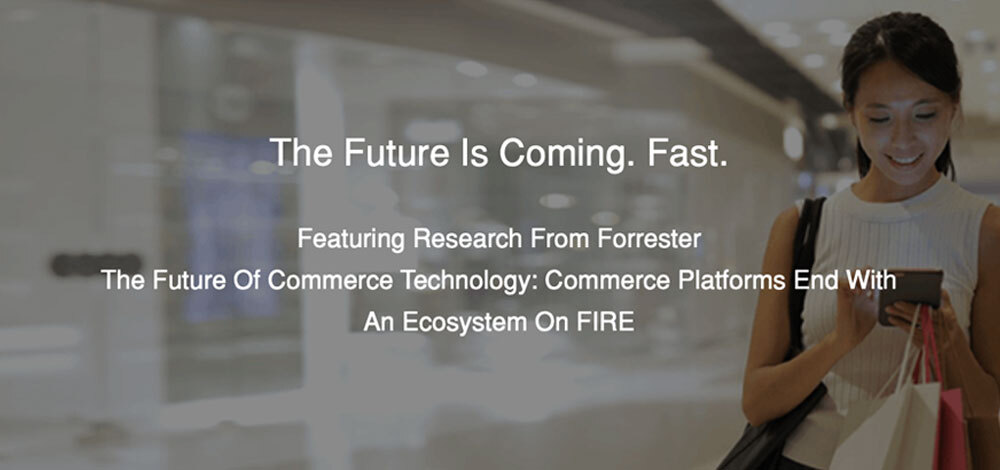Whenever I’m asked to predict where digital commerce is headed, I immediately think of the book, The Future is Faster Than You Think by Peter H. Diamandis and Steven Kotler.1 The title gives insight into the evolution of the digital commerce space, where the only aspect changing faster than the technology is the pace of change itself.
The Pandemic Exposed Problems And Illuminated Opportunities.
The last two tumultuous years accelerated the development of commerce technology and architectural approaches to building with these new tools. The COVID-19 pandemic forced an undeniable reckoning for anyone hiding behind faulty assumptions and delayed investment.
Many retailers believed their omnichannel experience was a success. But as the pandemic stripped away their brick-and-mortar presence, they had to face the stark reality that their online experience failed to keep pace. When physical stores slowly reopened, new customer expectations exposed more flaws, as they realized their Buy Online, Pick-up In-Store solution really didn’t work. But an 18-month implementation process was no longer an option. They needed new solutions — and fast.
Manufacturers that were strictly B2B faced a similar dilemma. Many realized that their supply chain wasn’t as elastic as they once thought. The need to quickly initiate a direct-to-consumer sales approach revealed once again how difficult their current commerce platform was to extend.
For almost every digital commerce company, the shift was jarring and illuminating. There has always been a struggle with the complexities, costs, and timelines to implement or enhance a digital commerce platform. However, the pandemic required agility most companies couldn’t muster, resulting in disappointing customer experiences with the added downside of customers being more willing to abandon carts, forego brand loyalty, and adopt new technology in their pursuit of groceries, and toilet paper, and other necessities.
The gap between digital commerce winners and laggards has widened — but as the following Forrester report, The Future of Commerce Technology: Commerce Platforms End With an Ecosystem on FIRE, shows, digital business leaders face new opportunities to recover and thrive.
Modern Software Isn’t Enough. Your Strategy And Approach Must Be Modern, Too.
Many companies realize their legacy software is holding them back. They want to improve digital experiences while keeping costs in check — and know that modernization is necessary to compete in our rapidly evolving commerce environment.
However, new tech alone won’t yield the long-term results they need. Modern software deployed with old thinking won’t move the need in the future. A different architectural approach must be utilized to avoid the problems we’re trying to leave behind.
Many crucial factors — such as how APIs are connected, what underlying tools are used throughout the commerce ecosystem (Payment, Promotions, PIM, OMS, ERP), and how easily components can be added or replaced — could be impacted more by how you architect and deploy than by what software you chose.
Furthermore, to successfully support these new stacks, you’ll need to rethink the makeup of your team, where frontend skills and knowledge begin to overshadow and supersede the fading importance of backend expertise.
To succeed using modern commerce tools, you’ll need to:
Combining A Modern Approach With Modern Tech Allows You To Deliver What Really Matters: A Frictionless Commerce Experience.
Creating frictionless commerce experiences has always been an underlying goal, but over the last two years, it has become a necessity. It’s a moving target that B2C and B2-B companies must chase. Customers will no longer wait for features or functionality that they can see and get elsewhere.
Shoppers want to start an experience online, visit a store, research products on their phone, digitally order items, and get their items in the store, at the curb, or delivered at home. And it’s a journey that must be frictionless.
As Forrester points out in the following report, the new paradigm of commerce platforms includes options that are more flexible, less expensive, quicker to deploy, and easier to use than the legacy systems of the past.If they are constructed in the right way (with the right team in place to support them) then delivering robust, meaningful, frictionless commerce journeys will be the future.1 Peter H. Diamandis and Steven Kotler, January 2020, The Future is Faster Than You Think. Publisher: Simon Schuster
The Frictionless Future of Commerce: How to Get Ahead of Evolving Customer Expectations
Featuring Research Report by Forrester
The Future of Commerce Technology: Commerce Platforms End with an Ecosystem on FIRE
The last year accelerated the development of commerce technology, as the pandemic forced an undeniable reckoning for many businesses still clinging to legacy systems.
The gap between digital commerce winners and laggards has widened — but as this Forrester report shows, digital business leaders face new opportunities to recover and thrive.
